Customer Relationship Management Analysis: Splash and Shukran Card
VerifiedAdded on 2023/05/28
|11
|3528
|134
Report
AI Summary
This report provides a comprehensive analysis of Customer Relationship Management (CRM) within the context of Splash, a major fashion retailer based in the UAE, and its associated Shukran Card rewards program. The report begins with an introduction to CRM and its rationale, emphasizing its importance for long-term business growth and customer satisfaction. It then details Splash's CRM approach, highlighting the use of the Shukran Card as a key tool for customer engagement and loyalty. The report also identifies key issues and challenges in CRM implementation, such as employee adoption, integration difficulties, and industry-specific hurdles like consumerism and inventory management. The research methodology, including both Agile and Waterfall methods, is discussed, along with the framework for collecting quantitative data. The report also explores sources and the use of secondary data like annual reports and internal records. A SWOT analysis of Splash is presented, followed by a discussion of research areas related to CRM in the retail sector. The report concludes by summarizing the effectiveness of CRM practices within Splash and their impact on customer relationships.
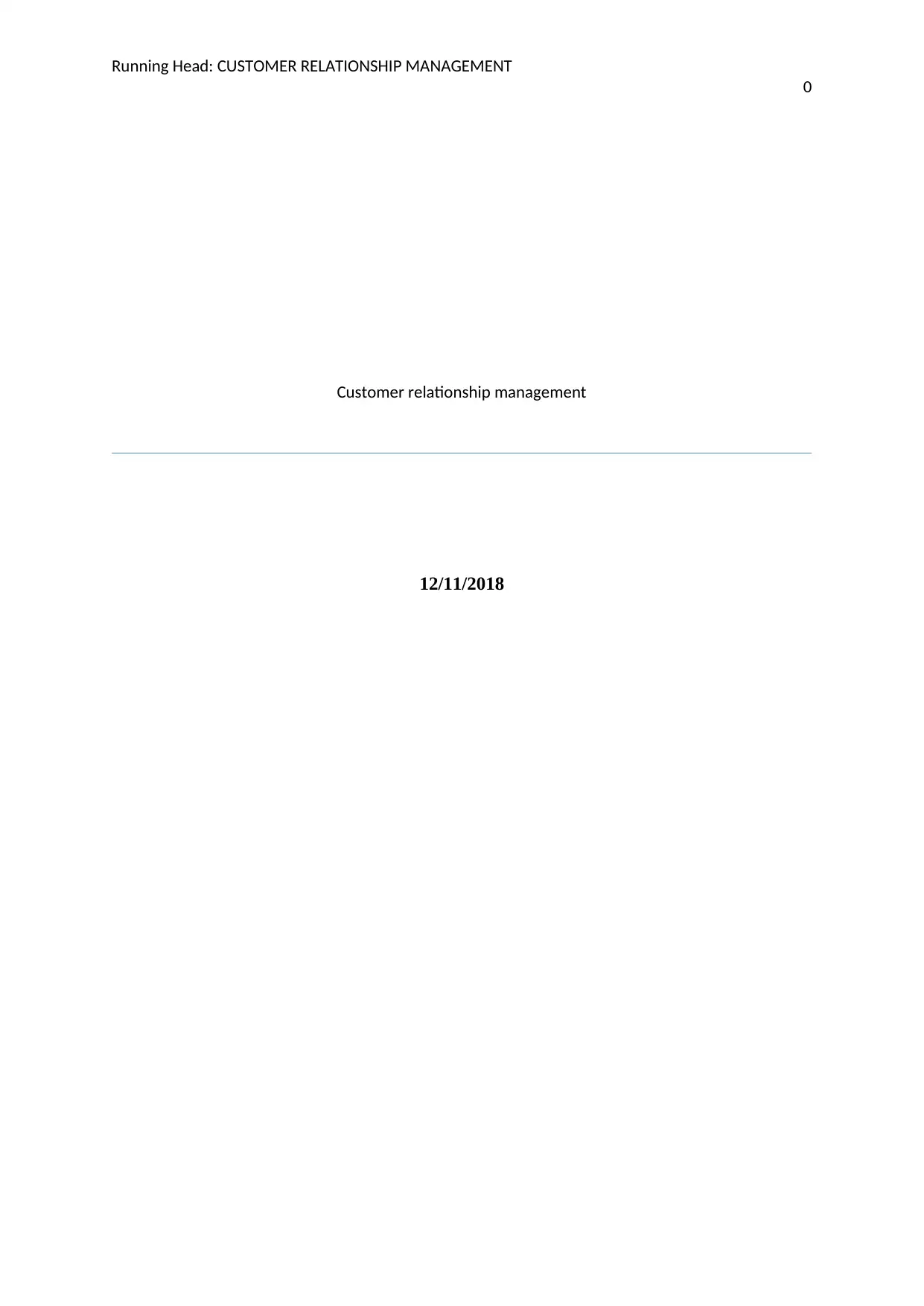
Running Head: CUSTOMER RELATIONSHIP MANAGEMENT
0
Customer relationship management
12/11/2018
0
Customer relationship management
12/11/2018
Paraphrase This Document
Need a fresh take? Get an instant paraphrase of this document with our AI Paraphraser
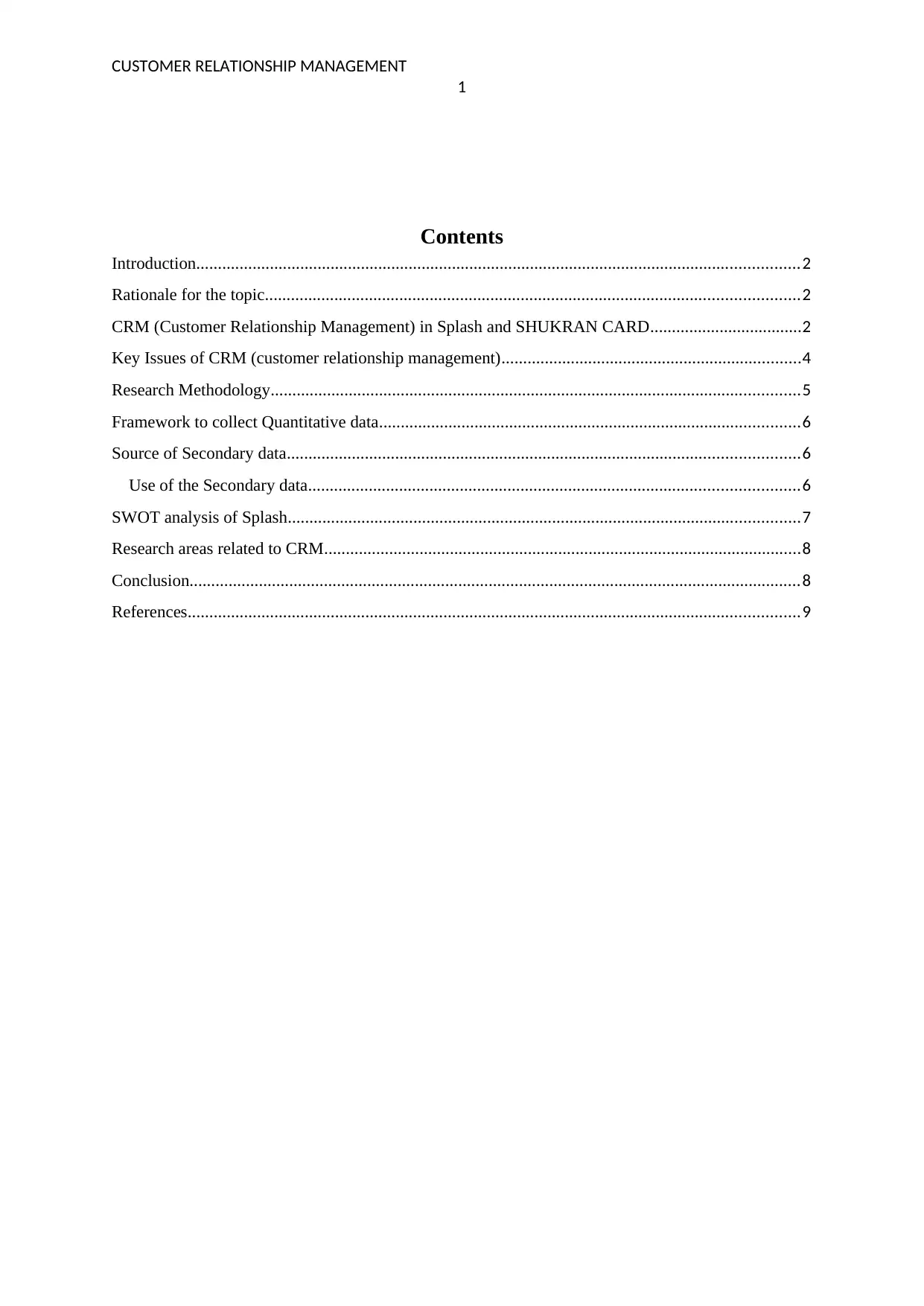
CUSTOMER RELATIONSHIP MANAGEMENT
1
Contents
Introduction...........................................................................................................................................2
Rationale for the topic...........................................................................................................................2
CRM (Customer Relationship Management) in Splash and SHUKRAN CARD...................................2
Key Issues of CRM (customer relationship management).....................................................................4
Research Methodology..........................................................................................................................5
Framework to collect Quantitative data.................................................................................................6
Source of Secondary data......................................................................................................................6
Use of the Secondary data.................................................................................................................6
SWOT analysis of Splash......................................................................................................................7
Research areas related to CRM..............................................................................................................8
Conclusion.............................................................................................................................................8
References.............................................................................................................................................9
1
Contents
Introduction...........................................................................................................................................2
Rationale for the topic...........................................................................................................................2
CRM (Customer Relationship Management) in Splash and SHUKRAN CARD...................................2
Key Issues of CRM (customer relationship management).....................................................................4
Research Methodology..........................................................................................................................5
Framework to collect Quantitative data.................................................................................................6
Source of Secondary data......................................................................................................................6
Use of the Secondary data.................................................................................................................6
SWOT analysis of Splash......................................................................................................................7
Research areas related to CRM..............................................................................................................8
Conclusion.............................................................................................................................................8
References.............................................................................................................................................9
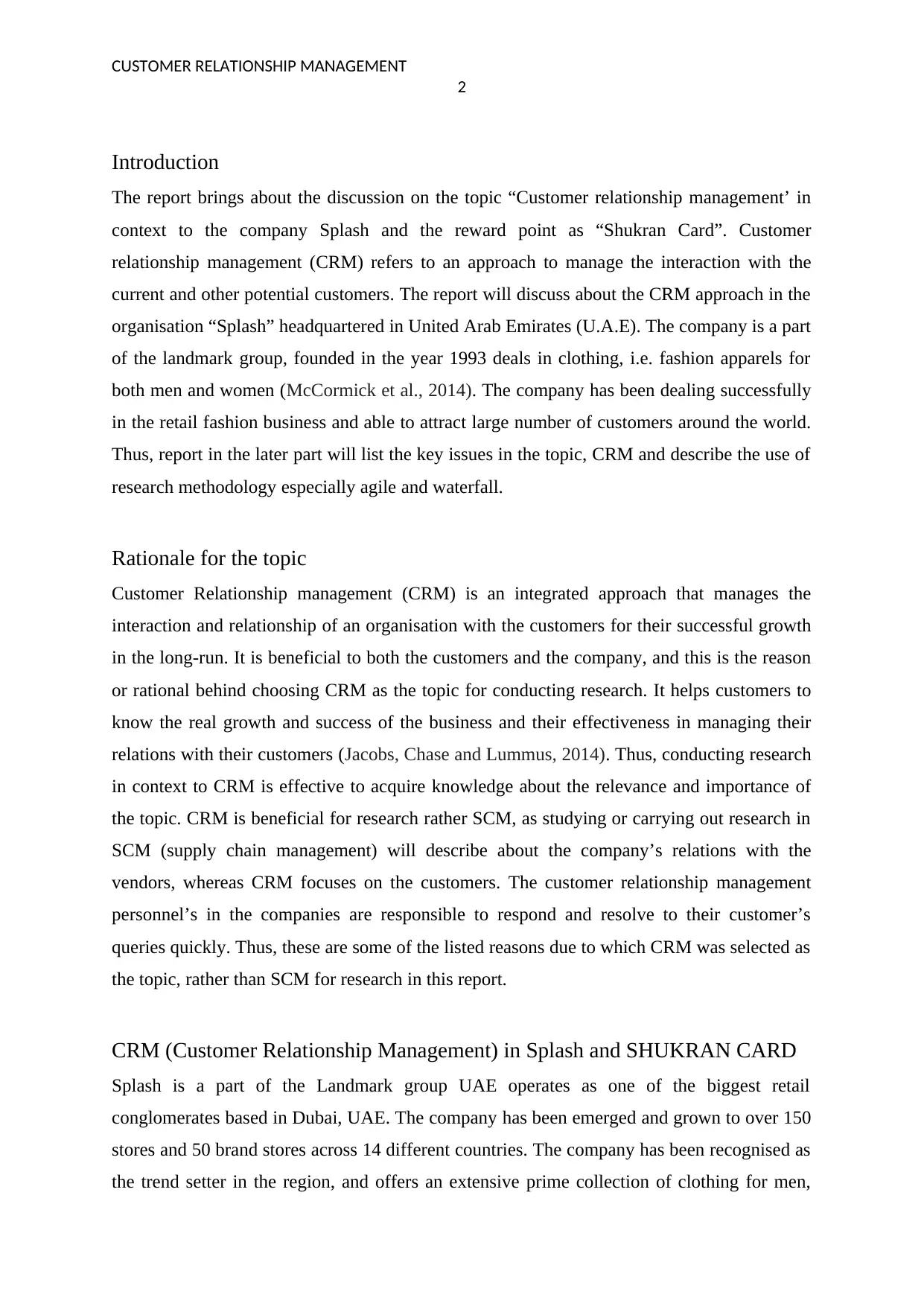
CUSTOMER RELATIONSHIP MANAGEMENT
2
Introduction
The report brings about the discussion on the topic “Customer relationship management’ in
context to the company Splash and the reward point as “Shukran Card”. Customer
relationship management (CRM) refers to an approach to manage the interaction with the
current and other potential customers. The report will discuss about the CRM approach in the
organisation “Splash” headquartered in United Arab Emirates (U.A.E). The company is a part
of the landmark group, founded in the year 1993 deals in clothing, i.e. fashion apparels for
both men and women (McCormick et al., 2014). The company has been dealing successfully
in the retail fashion business and able to attract large number of customers around the world.
Thus, report in the later part will list the key issues in the topic, CRM and describe the use of
research methodology especially agile and waterfall.
Rationale for the topic
Customer Relationship management (CRM) is an integrated approach that manages the
interaction and relationship of an organisation with the customers for their successful growth
in the long-run. It is beneficial to both the customers and the company, and this is the reason
or rational behind choosing CRM as the topic for conducting research. It helps customers to
know the real growth and success of the business and their effectiveness in managing their
relations with their customers (Jacobs, Chase and Lummus, 2014). Thus, conducting research
in context to CRM is effective to acquire knowledge about the relevance and importance of
the topic. CRM is beneficial for research rather SCM, as studying or carrying out research in
SCM (supply chain management) will describe about the company’s relations with the
vendors, whereas CRM focuses on the customers. The customer relationship management
personnel’s in the companies are responsible to respond and resolve to their customer’s
queries quickly. Thus, these are some of the listed reasons due to which CRM was selected as
the topic, rather than SCM for research in this report.
CRM (Customer Relationship Management) in Splash and SHUKRAN CARD
Splash is a part of the Landmark group UAE operates as one of the biggest retail
conglomerates based in Dubai, UAE. The company has been emerged and grown to over 150
stores and 50 brand stores across 14 different countries. The company has been recognised as
the trend setter in the region, and offers an extensive prime collection of clothing for men,
2
Introduction
The report brings about the discussion on the topic “Customer relationship management’ in
context to the company Splash and the reward point as “Shukran Card”. Customer
relationship management (CRM) refers to an approach to manage the interaction with the
current and other potential customers. The report will discuss about the CRM approach in the
organisation “Splash” headquartered in United Arab Emirates (U.A.E). The company is a part
of the landmark group, founded in the year 1993 deals in clothing, i.e. fashion apparels for
both men and women (McCormick et al., 2014). The company has been dealing successfully
in the retail fashion business and able to attract large number of customers around the world.
Thus, report in the later part will list the key issues in the topic, CRM and describe the use of
research methodology especially agile and waterfall.
Rationale for the topic
Customer Relationship management (CRM) is an integrated approach that manages the
interaction and relationship of an organisation with the customers for their successful growth
in the long-run. It is beneficial to both the customers and the company, and this is the reason
or rational behind choosing CRM as the topic for conducting research. It helps customers to
know the real growth and success of the business and their effectiveness in managing their
relations with their customers (Jacobs, Chase and Lummus, 2014). Thus, conducting research
in context to CRM is effective to acquire knowledge about the relevance and importance of
the topic. CRM is beneficial for research rather SCM, as studying or carrying out research in
SCM (supply chain management) will describe about the company’s relations with the
vendors, whereas CRM focuses on the customers. The customer relationship management
personnel’s in the companies are responsible to respond and resolve to their customer’s
queries quickly. Thus, these are some of the listed reasons due to which CRM was selected as
the topic, rather than SCM for research in this report.
CRM (Customer Relationship Management) in Splash and SHUKRAN CARD
Splash is a part of the Landmark group UAE operates as one of the biggest retail
conglomerates based in Dubai, UAE. The company has been emerged and grown to over 150
stores and 50 brand stores across 14 different countries. The company has been recognised as
the trend setter in the region, and offers an extensive prime collection of clothing for men,
⊘ This is a preview!⊘
Do you want full access?
Subscribe today to unlock all pages.

Trusted by 1+ million students worldwide

CUSTOMER RELATIONSHIP MANAGEMENT
3
women, and the teens. In addition, the company has been identified as one of the best place to
work for in the UAE.
CRM in splash has been well operated, and monitored as the retail business has been
effective in storing customer and prospect data, and tracks customer interactions effectively.
As discussing about the approach of CRM, it is referred to a CRM tool, which helped Splash
in managing contact, sales management activities, workflow processes, productivity, and
other such processes. Thus, CRM software or the tool helps the fashion retail business to
manage and improve their interactions with their customers, and access to the customer data
and business information (Castaldo and Grosso, 2016).
The companies like Splash as one of the biggest apparel retailers are involved in extensive
advertising of their products to enhance the interest and interaction with their customers.
Advertisements helps the company to increase customer loyalty towards their products and
other offerings, as the clothing retailers always aim at retaining their current as well as future
customers in the long-term. The aspects of customer orientation, relationship marketing, and
database marketing form the crux of the CRM in Splash (Kaul, 2017).
SHUKRAN CARD is used as one of the CRM tool in the fashion retail, Splash as a reward
point in their organisation. It is an exciting reward programme used by the fashion retail,
Splash as a way to thank their customers and it can be used at any outlet to earn or redeem
any reward points against the expenditure. Shukran is the landmark group’s award-winning
loyalty programme, especially found in the Middle East, which has been designed to offer
better rewarding shopping experience at Splash (Costa et al., 2017).
Members or customers earn valuable Shukrans on the purchase made by them and they utilize
the card on the instant savings on every product offered by the company, such as accessories,
footwear, clothing, furnishings, electronics, restaurants, and others. Thus, analysing the tool
of CRM established in the fashion retail it has been observed that customer’s provided
positive response or feedback and stated that Shukran provides real rewards for the money
invested in the products (Kerbache, Amann and Burquel, 2017)
Thus, the above description has stated that the company is able to establish and nurture sound
relationships with their customers in the market, which indicated about effective Customer
relationship management practices in the company leading to higher success.
3
women, and the teens. In addition, the company has been identified as one of the best place to
work for in the UAE.
CRM in splash has been well operated, and monitored as the retail business has been
effective in storing customer and prospect data, and tracks customer interactions effectively.
As discussing about the approach of CRM, it is referred to a CRM tool, which helped Splash
in managing contact, sales management activities, workflow processes, productivity, and
other such processes. Thus, CRM software or the tool helps the fashion retail business to
manage and improve their interactions with their customers, and access to the customer data
and business information (Castaldo and Grosso, 2016).
The companies like Splash as one of the biggest apparel retailers are involved in extensive
advertising of their products to enhance the interest and interaction with their customers.
Advertisements helps the company to increase customer loyalty towards their products and
other offerings, as the clothing retailers always aim at retaining their current as well as future
customers in the long-term. The aspects of customer orientation, relationship marketing, and
database marketing form the crux of the CRM in Splash (Kaul, 2017).
SHUKRAN CARD is used as one of the CRM tool in the fashion retail, Splash as a reward
point in their organisation. It is an exciting reward programme used by the fashion retail,
Splash as a way to thank their customers and it can be used at any outlet to earn or redeem
any reward points against the expenditure. Shukran is the landmark group’s award-winning
loyalty programme, especially found in the Middle East, which has been designed to offer
better rewarding shopping experience at Splash (Costa et al., 2017).
Members or customers earn valuable Shukrans on the purchase made by them and they utilize
the card on the instant savings on every product offered by the company, such as accessories,
footwear, clothing, furnishings, electronics, restaurants, and others. Thus, analysing the tool
of CRM established in the fashion retail it has been observed that customer’s provided
positive response or feedback and stated that Shukran provides real rewards for the money
invested in the products (Kerbache, Amann and Burquel, 2017)
Thus, the above description has stated that the company is able to establish and nurture sound
relationships with their customers in the market, which indicated about effective Customer
relationship management practices in the company leading to higher success.
Paraphrase This Document
Need a fresh take? Get an instant paraphrase of this document with our AI Paraphraser
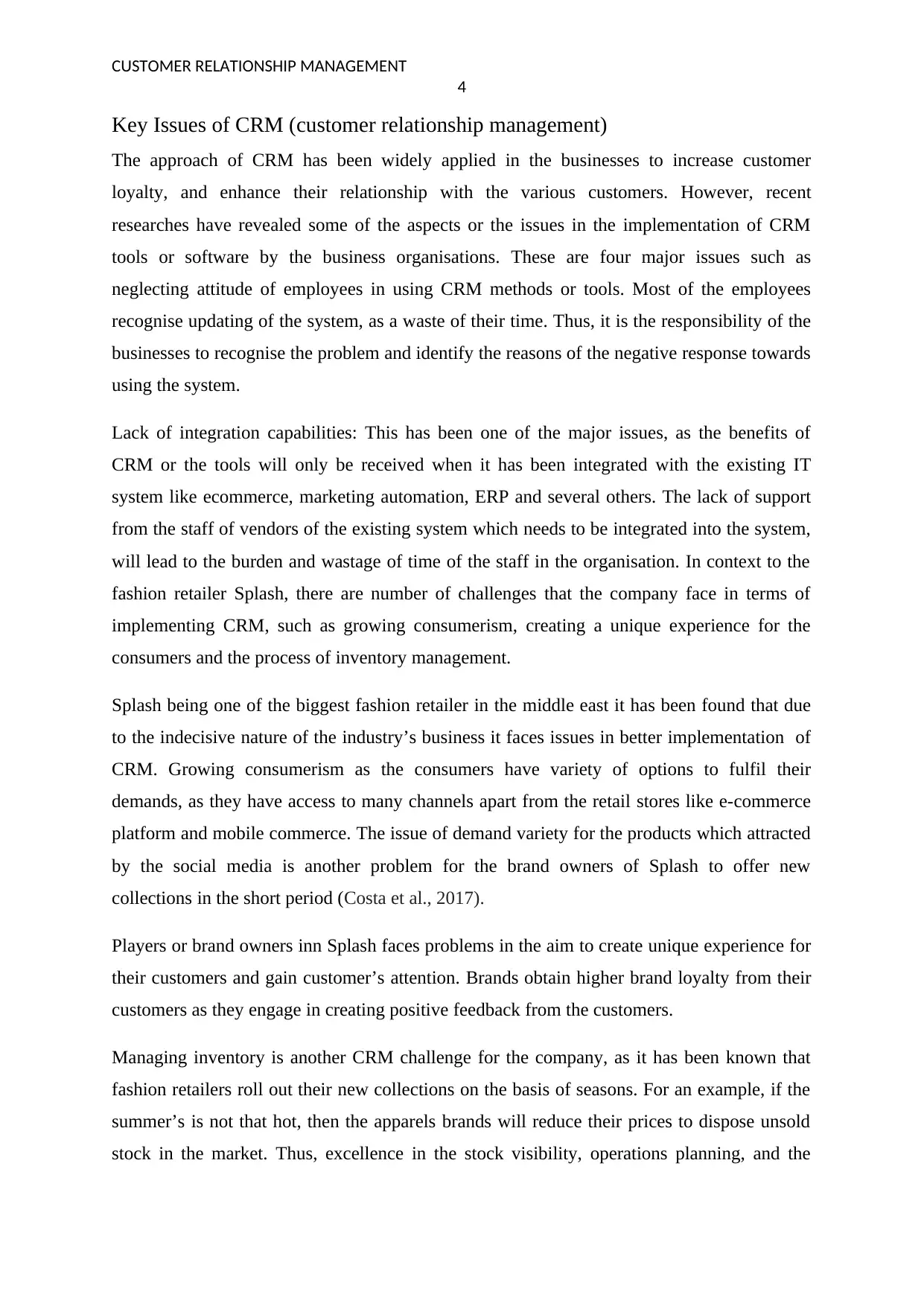
CUSTOMER RELATIONSHIP MANAGEMENT
4
Key Issues of CRM (customer relationship management)
The approach of CRM has been widely applied in the businesses to increase customer
loyalty, and enhance their relationship with the various customers. However, recent
researches have revealed some of the aspects or the issues in the implementation of CRM
tools or software by the business organisations. These are four major issues such as
neglecting attitude of employees in using CRM methods or tools. Most of the employees
recognise updating of the system, as a waste of their time. Thus, it is the responsibility of the
businesses to recognise the problem and identify the reasons of the negative response towards
using the system.
Lack of integration capabilities: This has been one of the major issues, as the benefits of
CRM or the tools will only be received when it has been integrated with the existing IT
system like ecommerce, marketing automation, ERP and several others. The lack of support
from the staff of vendors of the existing system which needs to be integrated into the system,
will lead to the burden and wastage of time of the staff in the organisation. In context to the
fashion retailer Splash, there are number of challenges that the company face in terms of
implementing CRM, such as growing consumerism, creating a unique experience for the
consumers and the process of inventory management.
Splash being one of the biggest fashion retailer in the middle east it has been found that due
to the indecisive nature of the industry’s business it faces issues in better implementation of
CRM. Growing consumerism as the consumers have variety of options to fulfil their
demands, as they have access to many channels apart from the retail stores like e-commerce
platform and mobile commerce. The issue of demand variety for the products which attracted
by the social media is another problem for the brand owners of Splash to offer new
collections in the short period (Costa et al., 2017).
Players or brand owners inn Splash faces problems in the aim to create unique experience for
their customers and gain customer’s attention. Brands obtain higher brand loyalty from their
customers as they engage in creating positive feedback from the customers.
Managing inventory is another CRM challenge for the company, as it has been known that
fashion retailers roll out their new collections on the basis of seasons. For an example, if the
summer’s is not that hot, then the apparels brands will reduce their prices to dispose unsold
stock in the market. Thus, excellence in the stock visibility, operations planning, and the
4
Key Issues of CRM (customer relationship management)
The approach of CRM has been widely applied in the businesses to increase customer
loyalty, and enhance their relationship with the various customers. However, recent
researches have revealed some of the aspects or the issues in the implementation of CRM
tools or software by the business organisations. These are four major issues such as
neglecting attitude of employees in using CRM methods or tools. Most of the employees
recognise updating of the system, as a waste of their time. Thus, it is the responsibility of the
businesses to recognise the problem and identify the reasons of the negative response towards
using the system.
Lack of integration capabilities: This has been one of the major issues, as the benefits of
CRM or the tools will only be received when it has been integrated with the existing IT
system like ecommerce, marketing automation, ERP and several others. The lack of support
from the staff of vendors of the existing system which needs to be integrated into the system,
will lead to the burden and wastage of time of the staff in the organisation. In context to the
fashion retailer Splash, there are number of challenges that the company face in terms of
implementing CRM, such as growing consumerism, creating a unique experience for the
consumers and the process of inventory management.
Splash being one of the biggest fashion retailer in the middle east it has been found that due
to the indecisive nature of the industry’s business it faces issues in better implementation of
CRM. Growing consumerism as the consumers have variety of options to fulfil their
demands, as they have access to many channels apart from the retail stores like e-commerce
platform and mobile commerce. The issue of demand variety for the products which attracted
by the social media is another problem for the brand owners of Splash to offer new
collections in the short period (Costa et al., 2017).
Players or brand owners inn Splash faces problems in the aim to create unique experience for
their customers and gain customer’s attention. Brands obtain higher brand loyalty from their
customers as they engage in creating positive feedback from the customers.
Managing inventory is another CRM challenge for the company, as it has been known that
fashion retailers roll out their new collections on the basis of seasons. For an example, if the
summer’s is not that hot, then the apparels brands will reduce their prices to dispose unsold
stock in the market. Thus, excellence in the stock visibility, operations planning, and the
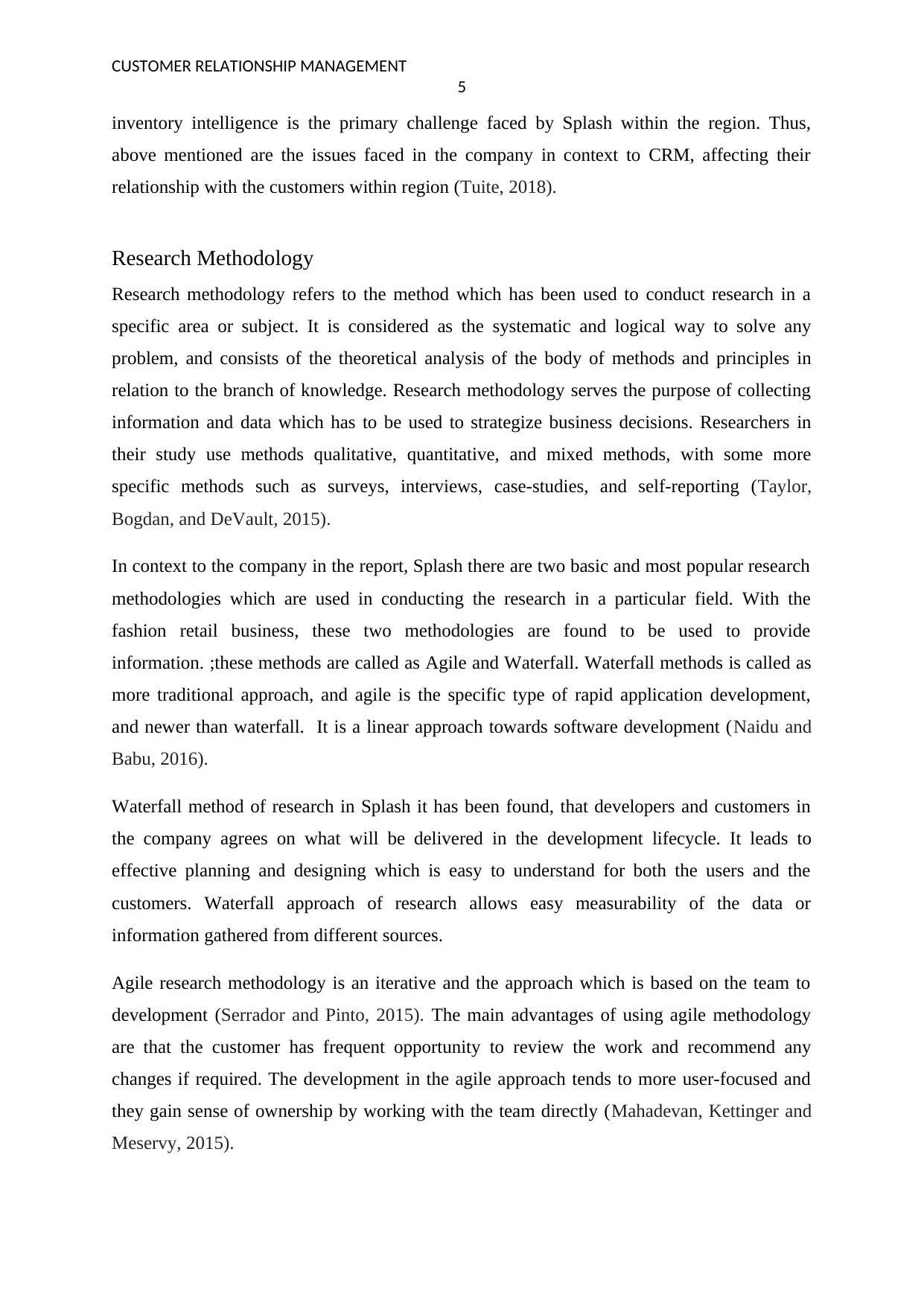
CUSTOMER RELATIONSHIP MANAGEMENT
5
inventory intelligence is the primary challenge faced by Splash within the region. Thus,
above mentioned are the issues faced in the company in context to CRM, affecting their
relationship with the customers within region (Tuite, 2018).
Research Methodology
Research methodology refers to the method which has been used to conduct research in a
specific area or subject. It is considered as the systematic and logical way to solve any
problem, and consists of the theoretical analysis of the body of methods and principles in
relation to the branch of knowledge. Research methodology serves the purpose of collecting
information and data which has to be used to strategize business decisions. Researchers in
their study use methods qualitative, quantitative, and mixed methods, with some more
specific methods such as surveys, interviews, case-studies, and self-reporting (Taylor,
Bogdan, and DeVault, 2015).
In context to the company in the report, Splash there are two basic and most popular research
methodologies which are used in conducting the research in a particular field. With the
fashion retail business, these two methodologies are found to be used to provide
information. ;these methods are called as Agile and Waterfall. Waterfall methods is called as
more traditional approach, and agile is the specific type of rapid application development,
and newer than waterfall. It is a linear approach towards software development (Naidu and
Babu, 2016).
Waterfall method of research in Splash it has been found, that developers and customers in
the company agrees on what will be delivered in the development lifecycle. It leads to
effective planning and designing which is easy to understand for both the users and the
customers. Waterfall approach of research allows easy measurability of the data or
information gathered from different sources.
Agile research methodology is an iterative and the approach which is based on the team to
development (Serrador and Pinto, 2015). The main advantages of using agile methodology
are that the customer has frequent opportunity to review the work and recommend any
changes if required. The development in the agile approach tends to more user-focused and
they gain sense of ownership by working with the team directly (Mahadevan, Kettinger and
Meservy, 2015).
5
inventory intelligence is the primary challenge faced by Splash within the region. Thus,
above mentioned are the issues faced in the company in context to CRM, affecting their
relationship with the customers within region (Tuite, 2018).
Research Methodology
Research methodology refers to the method which has been used to conduct research in a
specific area or subject. It is considered as the systematic and logical way to solve any
problem, and consists of the theoretical analysis of the body of methods and principles in
relation to the branch of knowledge. Research methodology serves the purpose of collecting
information and data which has to be used to strategize business decisions. Researchers in
their study use methods qualitative, quantitative, and mixed methods, with some more
specific methods such as surveys, interviews, case-studies, and self-reporting (Taylor,
Bogdan, and DeVault, 2015).
In context to the company in the report, Splash there are two basic and most popular research
methodologies which are used in conducting the research in a particular field. With the
fashion retail business, these two methodologies are found to be used to provide
information. ;these methods are called as Agile and Waterfall. Waterfall methods is called as
more traditional approach, and agile is the specific type of rapid application development,
and newer than waterfall. It is a linear approach towards software development (Naidu and
Babu, 2016).
Waterfall method of research in Splash it has been found, that developers and customers in
the company agrees on what will be delivered in the development lifecycle. It leads to
effective planning and designing which is easy to understand for both the users and the
customers. Waterfall approach of research allows easy measurability of the data or
information gathered from different sources.
Agile research methodology is an iterative and the approach which is based on the team to
development (Serrador and Pinto, 2015). The main advantages of using agile methodology
are that the customer has frequent opportunity to review the work and recommend any
changes if required. The development in the agile approach tends to more user-focused and
they gain sense of ownership by working with the team directly (Mahadevan, Kettinger and
Meservy, 2015).
⊘ This is a preview!⊘
Do you want full access?
Subscribe today to unlock all pages.

Trusted by 1+ million students worldwide
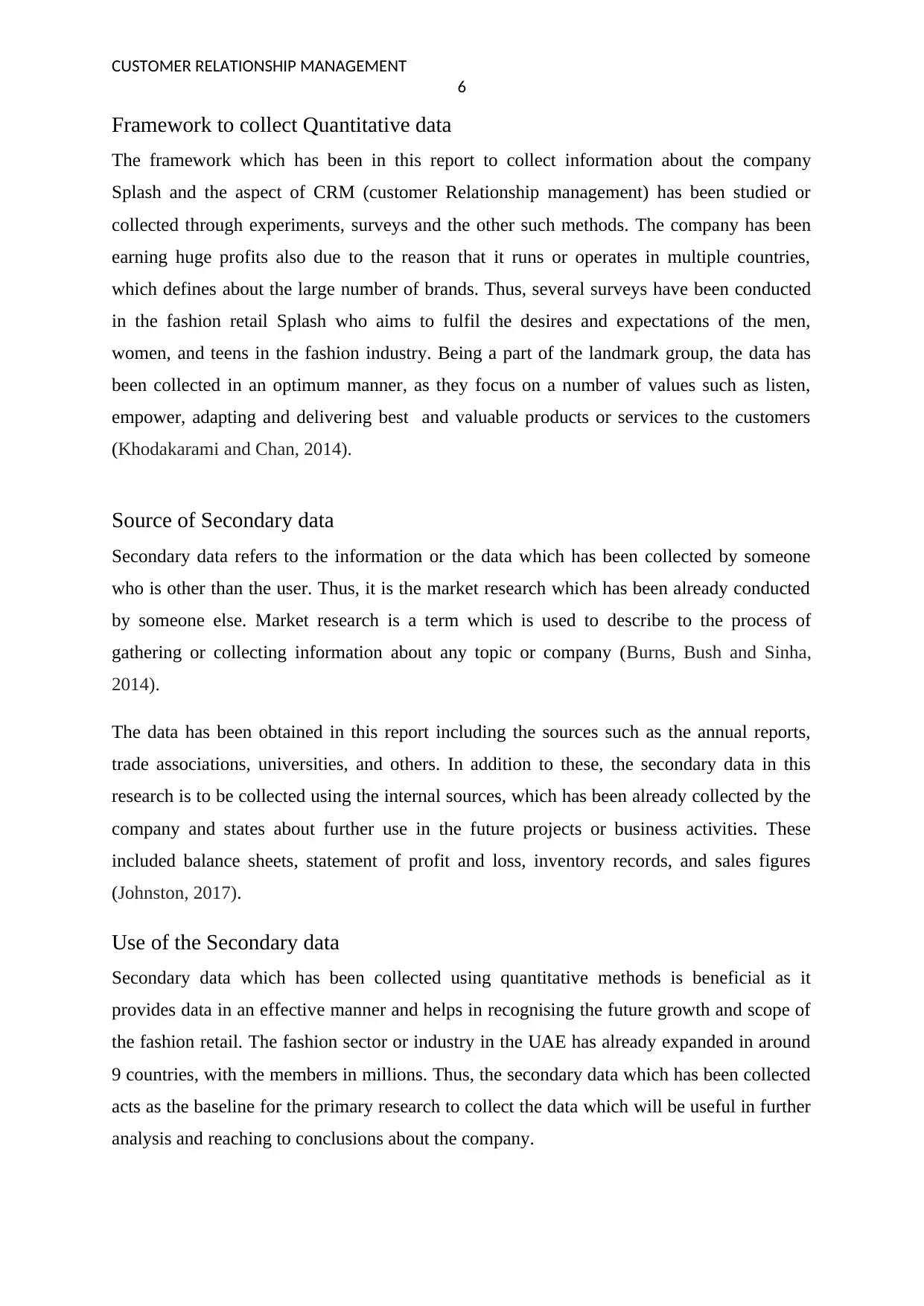
CUSTOMER RELATIONSHIP MANAGEMENT
6
Framework to collect Quantitative data
The framework which has been in this report to collect information about the company
Splash and the aspect of CRM (customer Relationship management) has been studied or
collected through experiments, surveys and the other such methods. The company has been
earning huge profits also due to the reason that it runs or operates in multiple countries,
which defines about the large number of brands. Thus, several surveys have been conducted
in the fashion retail Splash who aims to fulfil the desires and expectations of the men,
women, and teens in the fashion industry. Being a part of the landmark group, the data has
been collected in an optimum manner, as they focus on a number of values such as listen,
empower, adapting and delivering best and valuable products or services to the customers
(Khodakarami and Chan, 2014).
Source of Secondary data
Secondary data refers to the information or the data which has been collected by someone
who is other than the user. Thus, it is the market research which has been already conducted
by someone else. Market research is a term which is used to describe to the process of
gathering or collecting information about any topic or company (Burns, Bush and Sinha,
2014).
The data has been obtained in this report including the sources such as the annual reports,
trade associations, universities, and others. In addition to these, the secondary data in this
research is to be collected using the internal sources, which has been already collected by the
company and states about further use in the future projects or business activities. These
included balance sheets, statement of profit and loss, inventory records, and sales figures
(Johnston, 2017).
Use of the Secondary data
Secondary data which has been collected using quantitative methods is beneficial as it
provides data in an effective manner and helps in recognising the future growth and scope of
the fashion retail. The fashion sector or industry in the UAE has already expanded in around
9 countries, with the members in millions. Thus, the secondary data which has been collected
acts as the baseline for the primary research to collect the data which will be useful in further
analysis and reaching to conclusions about the company.
6
Framework to collect Quantitative data
The framework which has been in this report to collect information about the company
Splash and the aspect of CRM (customer Relationship management) has been studied or
collected through experiments, surveys and the other such methods. The company has been
earning huge profits also due to the reason that it runs or operates in multiple countries,
which defines about the large number of brands. Thus, several surveys have been conducted
in the fashion retail Splash who aims to fulfil the desires and expectations of the men,
women, and teens in the fashion industry. Being a part of the landmark group, the data has
been collected in an optimum manner, as they focus on a number of values such as listen,
empower, adapting and delivering best and valuable products or services to the customers
(Khodakarami and Chan, 2014).
Source of Secondary data
Secondary data refers to the information or the data which has been collected by someone
who is other than the user. Thus, it is the market research which has been already conducted
by someone else. Market research is a term which is used to describe to the process of
gathering or collecting information about any topic or company (Burns, Bush and Sinha,
2014).
The data has been obtained in this report including the sources such as the annual reports,
trade associations, universities, and others. In addition to these, the secondary data in this
research is to be collected using the internal sources, which has been already collected by the
company and states about further use in the future projects or business activities. These
included balance sheets, statement of profit and loss, inventory records, and sales figures
(Johnston, 2017).
Use of the Secondary data
Secondary data which has been collected using quantitative methods is beneficial as it
provides data in an effective manner and helps in recognising the future growth and scope of
the fashion retail. The fashion sector or industry in the UAE has already expanded in around
9 countries, with the members in millions. Thus, the secondary data which has been collected
acts as the baseline for the primary research to collect the data which will be useful in further
analysis and reaching to conclusions about the company.
Paraphrase This Document
Need a fresh take? Get an instant paraphrase of this document with our AI Paraphraser
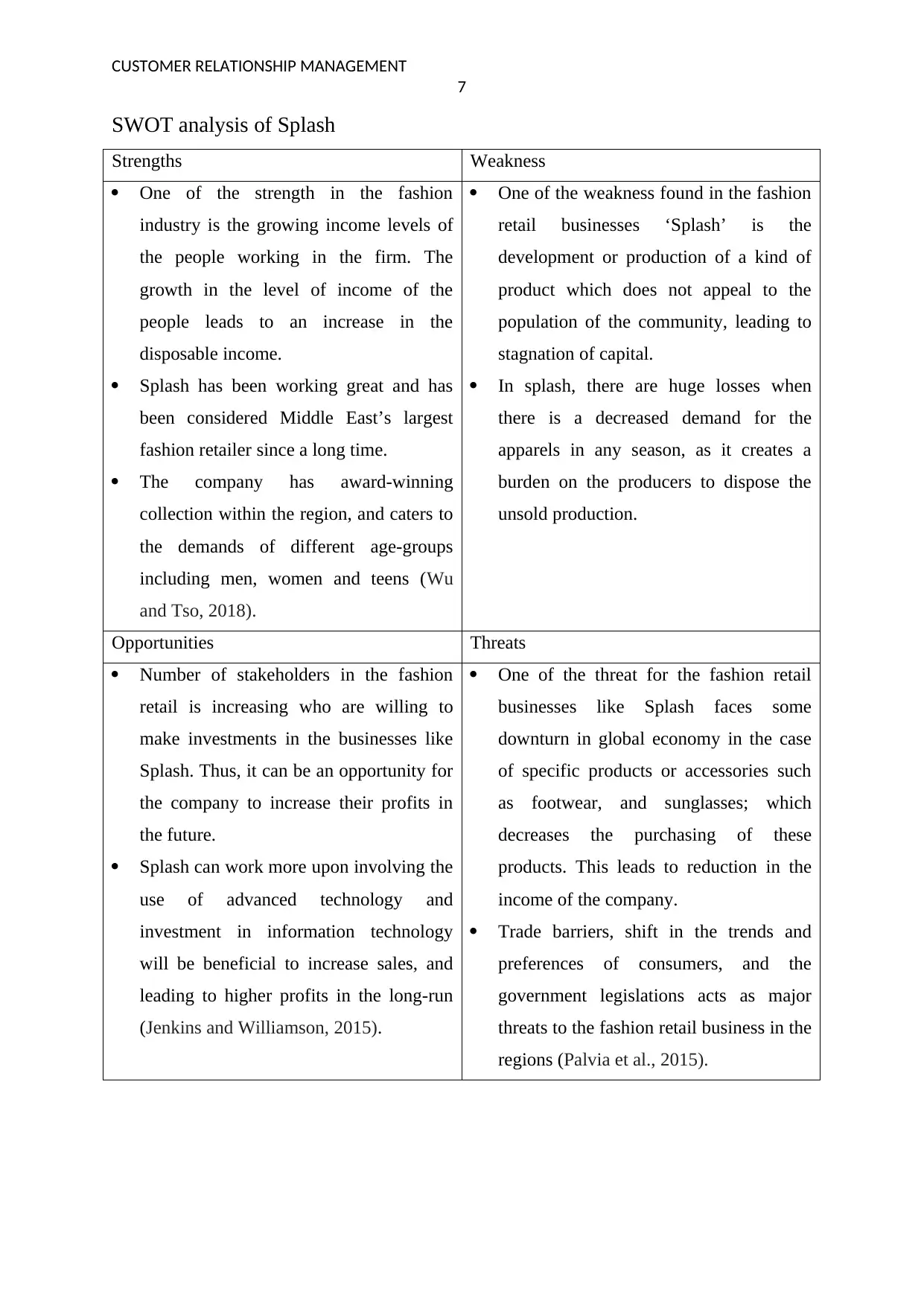
CUSTOMER RELATIONSHIP MANAGEMENT
7
SWOT analysis of Splash
Strengths Weakness
One of the strength in the fashion
industry is the growing income levels of
the people working in the firm. The
growth in the level of income of the
people leads to an increase in the
disposable income.
Splash has been working great and has
been considered Middle East’s largest
fashion retailer since a long time.
The company has award-winning
collection within the region, and caters to
the demands of different age-groups
including men, women and teens (Wu
and Tso, 2018).
One of the weakness found in the fashion
retail businesses ‘Splash’ is the
development or production of a kind of
product which does not appeal to the
population of the community, leading to
stagnation of capital.
In splash, there are huge losses when
there is a decreased demand for the
apparels in any season, as it creates a
burden on the producers to dispose the
unsold production.
Opportunities Threats
Number of stakeholders in the fashion
retail is increasing who are willing to
make investments in the businesses like
Splash. Thus, it can be an opportunity for
the company to increase their profits in
the future.
Splash can work more upon involving the
use of advanced technology and
investment in information technology
will be beneficial to increase sales, and
leading to higher profits in the long-run
(Jenkins and Williamson, 2015).
One of the threat for the fashion retail
businesses like Splash faces some
downturn in global economy in the case
of specific products or accessories such
as footwear, and sunglasses; which
decreases the purchasing of these
products. This leads to reduction in the
income of the company.
Trade barriers, shift in the trends and
preferences of consumers, and the
government legislations acts as major
threats to the fashion retail business in the
regions (Palvia et al., 2015).
7
SWOT analysis of Splash
Strengths Weakness
One of the strength in the fashion
industry is the growing income levels of
the people working in the firm. The
growth in the level of income of the
people leads to an increase in the
disposable income.
Splash has been working great and has
been considered Middle East’s largest
fashion retailer since a long time.
The company has award-winning
collection within the region, and caters to
the demands of different age-groups
including men, women and teens (Wu
and Tso, 2018).
One of the weakness found in the fashion
retail businesses ‘Splash’ is the
development or production of a kind of
product which does not appeal to the
population of the community, leading to
stagnation of capital.
In splash, there are huge losses when
there is a decreased demand for the
apparels in any season, as it creates a
burden on the producers to dispose the
unsold production.
Opportunities Threats
Number of stakeholders in the fashion
retail is increasing who are willing to
make investments in the businesses like
Splash. Thus, it can be an opportunity for
the company to increase their profits in
the future.
Splash can work more upon involving the
use of advanced technology and
investment in information technology
will be beneficial to increase sales, and
leading to higher profits in the long-run
(Jenkins and Williamson, 2015).
One of the threat for the fashion retail
businesses like Splash faces some
downturn in global economy in the case
of specific products or accessories such
as footwear, and sunglasses; which
decreases the purchasing of these
products. This leads to reduction in the
income of the company.
Trade barriers, shift in the trends and
preferences of consumers, and the
government legislations acts as major
threats to the fashion retail business in the
regions (Palvia et al., 2015).
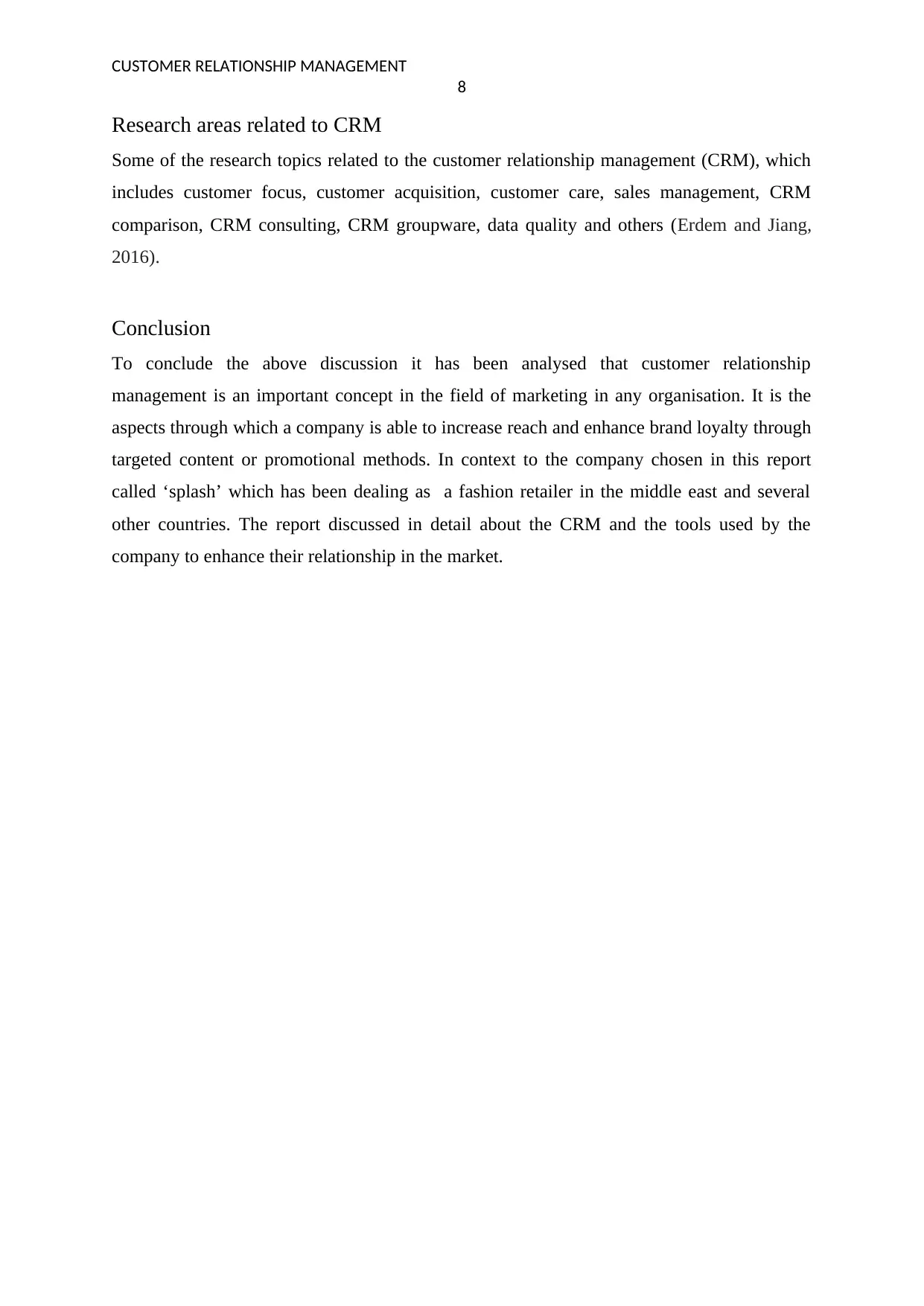
CUSTOMER RELATIONSHIP MANAGEMENT
8
Research areas related to CRM
Some of the research topics related to the customer relationship management (CRM), which
includes customer focus, customer acquisition, customer care, sales management, CRM
comparison, CRM consulting, CRM groupware, data quality and others (Erdem and Jiang,
2016).
Conclusion
To conclude the above discussion it has been analysed that customer relationship
management is an important concept in the field of marketing in any organisation. It is the
aspects through which a company is able to increase reach and enhance brand loyalty through
targeted content or promotional methods. In context to the company chosen in this report
called ‘splash’ which has been dealing as a fashion retailer in the middle east and several
other countries. The report discussed in detail about the CRM and the tools used by the
company to enhance their relationship in the market.
8
Research areas related to CRM
Some of the research topics related to the customer relationship management (CRM), which
includes customer focus, customer acquisition, customer care, sales management, CRM
comparison, CRM consulting, CRM groupware, data quality and others (Erdem and Jiang,
2016).
Conclusion
To conclude the above discussion it has been analysed that customer relationship
management is an important concept in the field of marketing in any organisation. It is the
aspects through which a company is able to increase reach and enhance brand loyalty through
targeted content or promotional methods. In context to the company chosen in this report
called ‘splash’ which has been dealing as a fashion retailer in the middle east and several
other countries. The report discussed in detail about the CRM and the tools used by the
company to enhance their relationship in the market.
⊘ This is a preview!⊘
Do you want full access?
Subscribe today to unlock all pages.

Trusted by 1+ million students worldwide
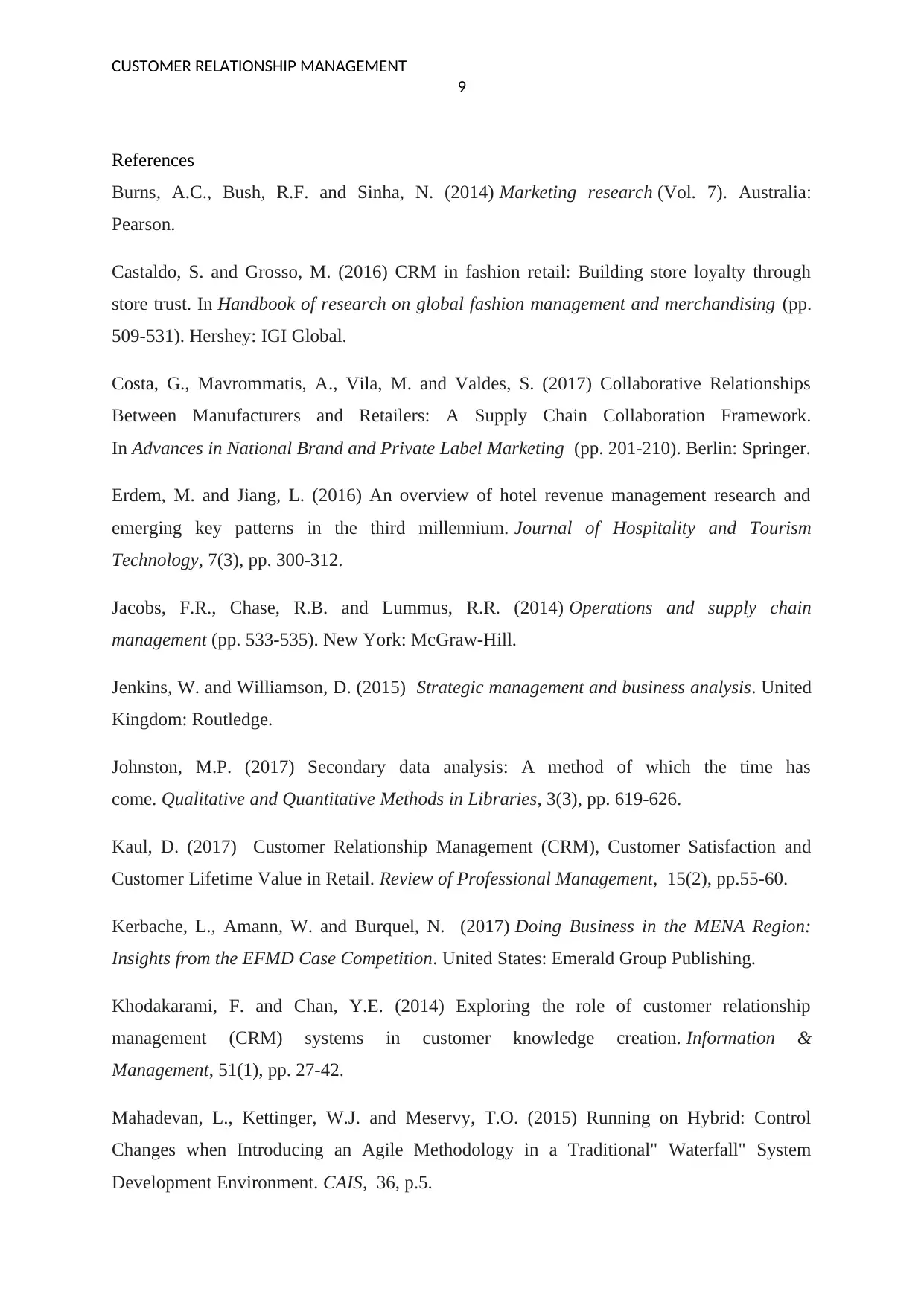
CUSTOMER RELATIONSHIP MANAGEMENT
9
References
Burns, A.C., Bush, R.F. and Sinha, N. (2014) Marketing research (Vol. 7). Australia:
Pearson.
Castaldo, S. and Grosso, M. (2016) CRM in fashion retail: Building store loyalty through
store trust. In Handbook of research on global fashion management and merchandising (pp.
509-531). Hershey: IGI Global.
Costa, G., Mavrommatis, A., Vila, M. and Valdes, S. (2017) Collaborative Relationships
Between Manufacturers and Retailers: A Supply Chain Collaboration Framework.
In Advances in National Brand and Private Label Marketing (pp. 201-210). Berlin: Springer.
Erdem, M. and Jiang, L. (2016) An overview of hotel revenue management research and
emerging key patterns in the third millennium. Journal of Hospitality and Tourism
Technology, 7(3), pp. 300-312.
Jacobs, F.R., Chase, R.B. and Lummus, R.R. (2014) Operations and supply chain
management (pp. 533-535). New York: McGraw-Hill.
Jenkins, W. and Williamson, D. (2015) Strategic management and business analysis. United
Kingdom: Routledge.
Johnston, M.P. (2017) Secondary data analysis: A method of which the time has
come. Qualitative and Quantitative Methods in Libraries, 3(3), pp. 619-626.
Kaul, D. (2017) Customer Relationship Management (CRM), Customer Satisfaction and
Customer Lifetime Value in Retail. Review of Professional Management, 15(2), pp.55-60.
Kerbache, L., Amann, W. and Burquel, N. (2017) Doing Business in the MENA Region:
Insights from the EFMD Case Competition. United States: Emerald Group Publishing.
Khodakarami, F. and Chan, Y.E. (2014) Exploring the role of customer relationship
management (CRM) systems in customer knowledge creation. Information &
Management, 51(1), pp. 27-42.
Mahadevan, L., Kettinger, W.J. and Meservy, T.O. (2015) Running on Hybrid: Control
Changes when Introducing an Agile Methodology in a Traditional" Waterfall" System
Development Environment. CAIS, 36, p.5.
9
References
Burns, A.C., Bush, R.F. and Sinha, N. (2014) Marketing research (Vol. 7). Australia:
Pearson.
Castaldo, S. and Grosso, M. (2016) CRM in fashion retail: Building store loyalty through
store trust. In Handbook of research on global fashion management and merchandising (pp.
509-531). Hershey: IGI Global.
Costa, G., Mavrommatis, A., Vila, M. and Valdes, S. (2017) Collaborative Relationships
Between Manufacturers and Retailers: A Supply Chain Collaboration Framework.
In Advances in National Brand and Private Label Marketing (pp. 201-210). Berlin: Springer.
Erdem, M. and Jiang, L. (2016) An overview of hotel revenue management research and
emerging key patterns in the third millennium. Journal of Hospitality and Tourism
Technology, 7(3), pp. 300-312.
Jacobs, F.R., Chase, R.B. and Lummus, R.R. (2014) Operations and supply chain
management (pp. 533-535). New York: McGraw-Hill.
Jenkins, W. and Williamson, D. (2015) Strategic management and business analysis. United
Kingdom: Routledge.
Johnston, M.P. (2017) Secondary data analysis: A method of which the time has
come. Qualitative and Quantitative Methods in Libraries, 3(3), pp. 619-626.
Kaul, D. (2017) Customer Relationship Management (CRM), Customer Satisfaction and
Customer Lifetime Value in Retail. Review of Professional Management, 15(2), pp.55-60.
Kerbache, L., Amann, W. and Burquel, N. (2017) Doing Business in the MENA Region:
Insights from the EFMD Case Competition. United States: Emerald Group Publishing.
Khodakarami, F. and Chan, Y.E. (2014) Exploring the role of customer relationship
management (CRM) systems in customer knowledge creation. Information &
Management, 51(1), pp. 27-42.
Mahadevan, L., Kettinger, W.J. and Meservy, T.O. (2015) Running on Hybrid: Control
Changes when Introducing an Agile Methodology in a Traditional" Waterfall" System
Development Environment. CAIS, 36, p.5.
Paraphrase This Document
Need a fresh take? Get an instant paraphrase of this document with our AI Paraphraser

CUSTOMER RELATIONSHIP MANAGEMENT
10
McCormick, H., Cartwright, J., Perry, P., Barnes, L., Lynch, S. and Ball, G. (2014) Fashion
retailing–past, present and future. Textile Progress, 46(3), pp. 227-321.
Naidu, G.R. and Babu, R.H. (2016) A Case Study Of: Clint Relationship Management
(CRM) Practices In Selected Organized Retail Outlets. IJSEAT, 4(2), pp. 091-099.
Palvia, P., Kakhki, M.D., Ghoshal, T., Uppala, V. and Wang, W. (2015) Methodological and
Topic Trends in Information Systems Research: A Meta-Analysis of IS Journals. CAIS, 37, p.
30.
Serrador, P. and Pinto, J.K. (2015) Does Agile work?—A quantitative analysis of agile
project success. International Journal of Project Management, 33(5), pp. 1040-1051.
Taylor, S.J., Bogdan, R. and DeVault, M. (2015) Introduction to qualitative research
methods: A guidebook and resource. United States: John Wiley & Sons.
Tuite, A. (2018) Jenny Kee and Flamingo Park: Independent fashion retailers as creative
practitioners. Fashion, Style & Popular Culture, 5(2), pp.169-183.
Wu, C.W. and Tso, K.F.G. (2018) Good Practices and Considerations in Conducting Email
Survey for Fashion Retail Industry. In Contemporary Case Studies on Fashion Production,
Marketing and Operations (pp. 105-117). Berlin: Springer.
10
McCormick, H., Cartwright, J., Perry, P., Barnes, L., Lynch, S. and Ball, G. (2014) Fashion
retailing–past, present and future. Textile Progress, 46(3), pp. 227-321.
Naidu, G.R. and Babu, R.H. (2016) A Case Study Of: Clint Relationship Management
(CRM) Practices In Selected Organized Retail Outlets. IJSEAT, 4(2), pp. 091-099.
Palvia, P., Kakhki, M.D., Ghoshal, T., Uppala, V. and Wang, W. (2015) Methodological and
Topic Trends in Information Systems Research: A Meta-Analysis of IS Journals. CAIS, 37, p.
30.
Serrador, P. and Pinto, J.K. (2015) Does Agile work?—A quantitative analysis of agile
project success. International Journal of Project Management, 33(5), pp. 1040-1051.
Taylor, S.J., Bogdan, R. and DeVault, M. (2015) Introduction to qualitative research
methods: A guidebook and resource. United States: John Wiley & Sons.
Tuite, A. (2018) Jenny Kee and Flamingo Park: Independent fashion retailers as creative
practitioners. Fashion, Style & Popular Culture, 5(2), pp.169-183.
Wu, C.W. and Tso, K.F.G. (2018) Good Practices and Considerations in Conducting Email
Survey for Fashion Retail Industry. In Contemporary Case Studies on Fashion Production,
Marketing and Operations (pp. 105-117). Berlin: Springer.
1 out of 11
Related Documents
Your All-in-One AI-Powered Toolkit for Academic Success.
+13062052269
info@desklib.com
Available 24*7 on WhatsApp / Email
![[object Object]](/_next/static/media/star-bottom.7253800d.svg)
Unlock your academic potential
Copyright © 2020–2025 A2Z Services. All Rights Reserved. Developed and managed by ZUCOL.





